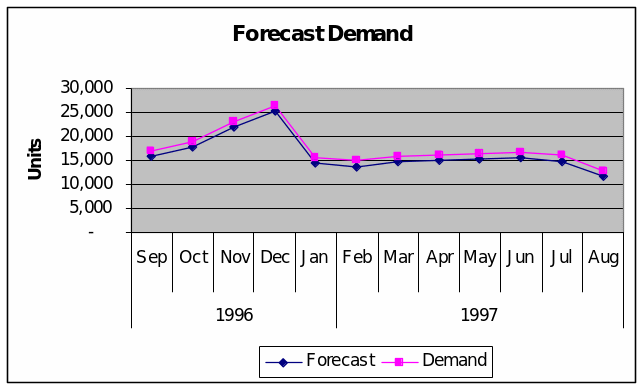Forecasted Demand
The forecasted values are derived from the figures provided for the year Sep 1996 to August 1997. The demand on the other hand is derived from the historic MAD and the forecast figures for the specified time range. The table below depicts the forecast and the demand for the wine bottles.

The plotted graph depicts that the demand for the wine bottles is fairly steady for the whole year from September 1996 to August 1997, except for November and December, with only minor fluctuation taking place in other months. November and December peak in demand for the wine bottles with the demand going as high as 26,000 bottles approximately. While the average median for the demand is 15,000 bottles for the rest of the months excluding November and December,
Inventory Costs for Fixed Order Quantity
The inventory plan under the fixed order quantity assumes that a fixed number of units would be ordered and managed in the inventory at all times around the year. Under the inventory plan, the order quantity is fixed for the whole year, and based on the information provided the value for December has been assumed as the fixed order quantity. As per the fixed order inventory plan, the holding costs stand at $10,527, with the cost of safety stock at $6,608 for a 99 percent service level and the ordering cost amounting to $8,820. The total cost of the inventory plan stands at $25,955
Inventory Costs for Fixed Time Period
The inventory plan under the fixed period assumes that orders would be placed at an interval with fixed periods. Under the inventory plan where the order period is fixed for the whole year, the holding costs stand at $9,206, with the cost of safety stock at $6,608 for a 99 percent service level and the ordering cost amounting to 8,820. The total cost of the inventory plan stands at $24,633.
Comparison and Review
The review of the two inventory plans has revealed that while the ordering and the safety stock costs for the inventory remain similar, the handling costs associated with the inventory are different for the two options. The fixed period option depicts a handling cost that stands at $10,527, while the fixed period inventory plan depicts a handling cost of $9,205. Therefore the total inventory costs for the two options differ from $25,955 for fixed orders and $24,633 for the fixed period. The more cost-effective option is the fixed period inventory plan and the NAPA winery should use this plan as an automated inventory forecasting tool.
References
‘Northern NAPA Valley Winery Inc.’, Richard School of Business, 2009